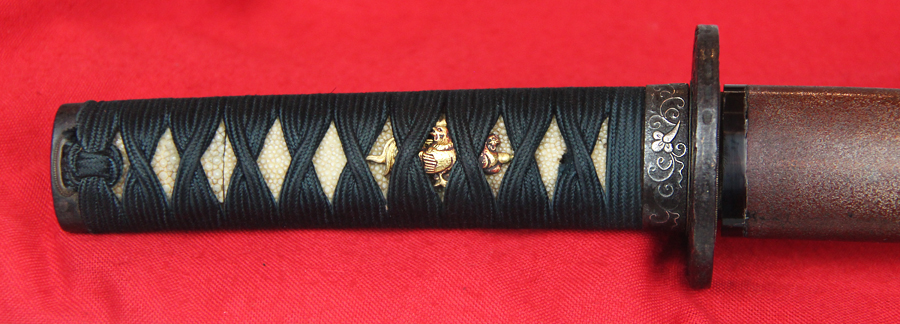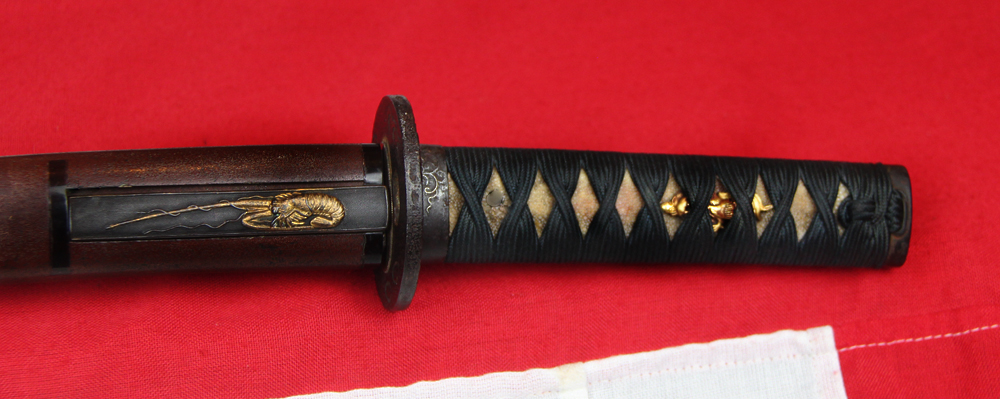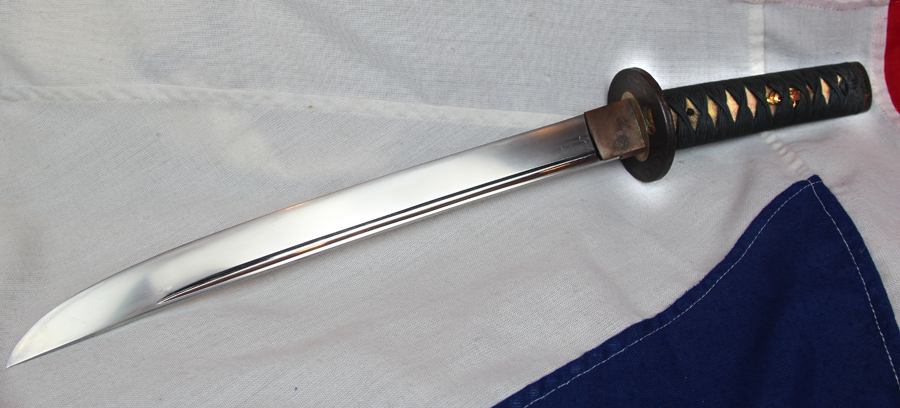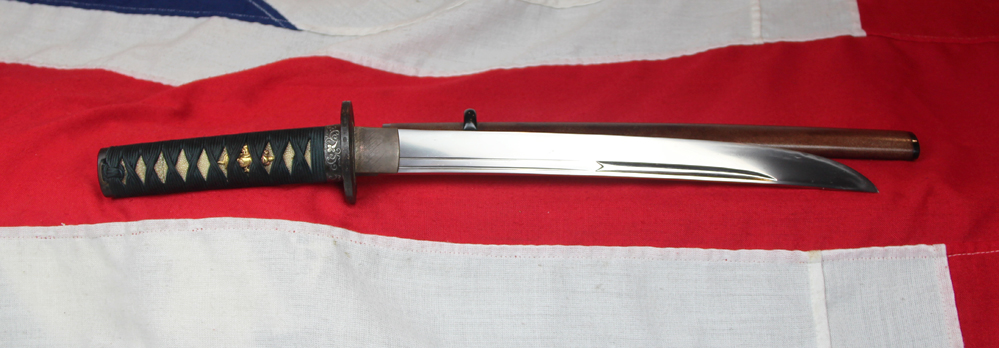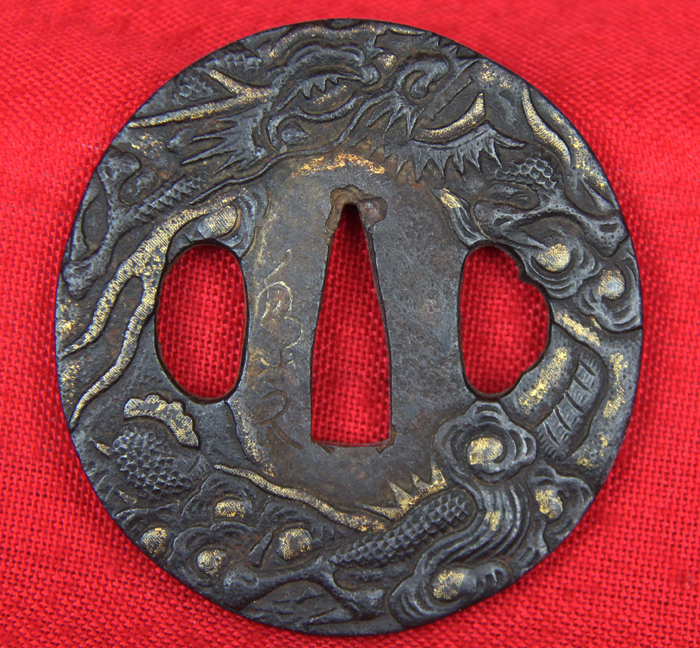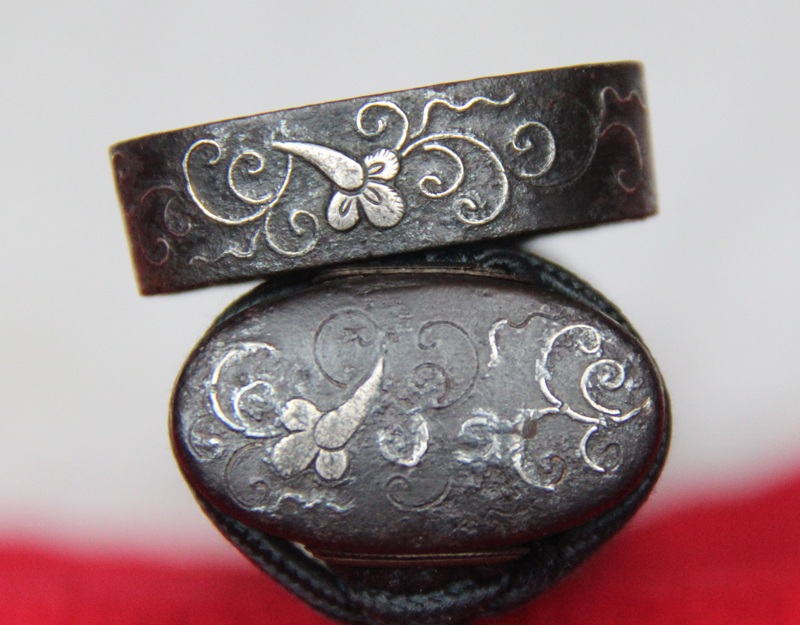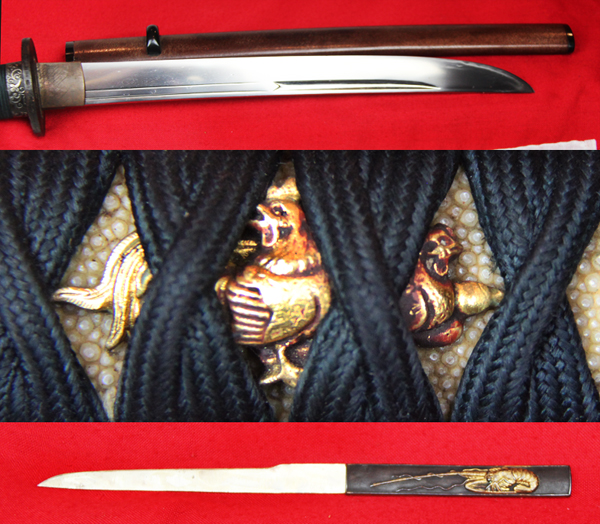A Stunning Japanese 0-Tanto Signed Echizen Kuni ju nin Kanenori Circa 1615
A very large Japanese samurai dagger around 400 years old possibly Keicho era. Beautifully mounted in its all original Edo period fittings of very fine quality. The takebori tsuba is decorated with a most finely executed dragon with pure gold highlights, and bears a large cursive signature by its maker. The fushigashira are iron inlaid with pure silver wire decoration of tendrils and flowers. The menuki are absolutely delightful of pure gold decorated twin pairs of cockerals in differing poses. The wide and long blade is most imposing, with a very unusual carved hi groove configuration. The original Edo urushi ishime lacquer saya has a fine kozuka utility knife fitted in its pocket that has a gold spiny lobster in takebori on very finely defined nanako ground see below for the detail on the nanako work, the rear of the kozuka handle is raindrop engraved with gold overlay
This beautiful large samurai dagger was made in and around the time of the famous clan conflict at Osaka Castle. In 1614, the Toyotomi clan rebuilt Osaka Castle. At the same time, the head of the clan sponsored the rebuilding of Hoko-ji in Kyoto. These temple renovations included the casting of a great bronze bell, with inscriptions that read "May the state be peaceful and prosperous" (kokka anko), and "May noble lord and servants be rich and cheerful" (kunshin horaku). The shogunate interpreted "kokka anko" as shattering Ieyasu's the Shogun name to curse him, and also interpreted "kunshin horaku" to mean "Toyotomi's force will rise again," which meant treachery against the new Tokugawa shogunate. Tensions began to grow between the Tokugawa and the Toyotomi clans, and only increased when Toyotomi began to gather a force of ronin mercenary samurai who had lost their lord and enemies of the shogunate in Osaka. Ieyasu, despite having passed the title of Shogun to his son in 1605, nevertheless maintained significant influence.
Despite Katagiri Katsumoto's attempts to mediate the situation, Ieyasu found the ideal pretext to take a belligerent attitude against Yodo-dono and Hideyori. The situation worsened for September of that year, when the news reached Edo that in Osaka they were grouping a large quantity of ronin-you are missing without a lord-at the invitation of Hideyori.
Katsumoto proposed to Yodo-dono be sent to Edo as a hostage with the desire to avoid hostilities, to which she flatly refused. Suspect of trying to betray the Toyotomi clan, Yodo-dono finally banished Katsumoto and several other servants accused of treason from Osaka castle, and go to the service of the Tokugawa clan, consequently any possibility of reaching an agreement with the shogunate was dissolved.
This last movement of Yodo-dono, who acted as the guardian of Hideyori, led to the beginning of the siege of Osaka. The siege of Osaka ( Osaka no Eki, or, more commonly, Osaka no Jin) was a series of battles undertaken by the Tokugawa shogunate against the Toyotomi clan, towards the end of the Keicho era, and ending in that clan's destruction. Divided into two stages (winter campaign and summer campaign), and lasting from 1614 to 1615, the siege put an end to the last major armed opposition to the shogunate's establishment. The end of the conflict is sometimes called the Genna Armistice ( Genna Enbu), because the era name was changed from Keicho to Genna immediately following the siege.
Nanako Ji: "fish roe ground" A surface decoration produced by forming very small raised bosses by a sharply struck punch or burin called 'nanako tagane'. Shakudo is the metal most often used, but copper and gold are quite often employed. The harder metals, shibuichi, silver and iron are rarely decorated in this way. The size of the dots vary from 0.04" to 0.008" (25 to 125 and inch) and the regularity of the work is marvelous as the dots must be spaced entirely by touch. The dots are usually arranged in straight lines or in lines parallel to the edge of the piece being decorated, but sometimes in more elaborate patterns. Used on guards since the Momoyama period although the technique existed since much earlier periods. Usually done by specialist 'nanako-shi', but sometimes done by the maker of the guard himself. The articles of sword ornamentation made by the Goto artists were practically all on shakudo grounds with nanako finish; after the emergence of the machibori artisans in the mid-Edo period and the popularity of the newly inspired kozuka, shakudo grounds with nanako finish "became the rage". Nanako finish is probably an evolution and refinement of a very old style finish (which it vaguely resembles); "millet finish", 'awa ishime', which is found on some old armorer tsuba. However, awa ishime consisted of small, round dimples punched into the surface of the ground; on the other hand, nanako is formed by striking the ground with a cup-shaped punch to raise, and project upward from the surface, small semi-hemispheric nipples. Since we find nanako finish on old yamagane grounds, it was in use as early as the Kamakura period. It is note-worthy that a nanako finish on a shakudo ground has been used since the time of the first Goto 1440 - 151 in the mitokoromono, "set of three", for use on formal or ceremonial occasions. Later, shakudo nanako became the regular finish for use by the metal artisans. (deleted repeated sentences) In applying nanako, meticulous and scrupulous care must be used in positioning and striking the "cupping tool" in order to achieve fine, regular, carefully and closely spaced, identical results, row after row. Careless, imprecise and even coarse workmanship can be detected in the nanako of some older works and on "ready made" products, but work of later years, executed with infinite and scrupulous care, are beautiful beyond belief. However, even the finest of execution of nanako finish applied to brass (shinchu) or shibuichi fails to carry the distinct air of refinement and elegance of similar work on shakudo. The very elegance of nanako workmanship reflects not only the extraordinary skills of the Japanese in the execution of minute, detailed work, but also their tremendous patience and artistic inspiration. It is said that blindness of nanako workers at thirty years of age was usual because of the microscopic and meticulous work so carefully and patiently executed. On many old tsuba, pre-dating the period of the Goto, one encounters nanako laid in horizontal or vertical rows; on subsequent work nanako was applied along curved lines conforming to the shape of the tsuba.
22.5 inches long overall, 14 inches long blade tsuba to tip.
Code: 22736
4250.00 GBP



